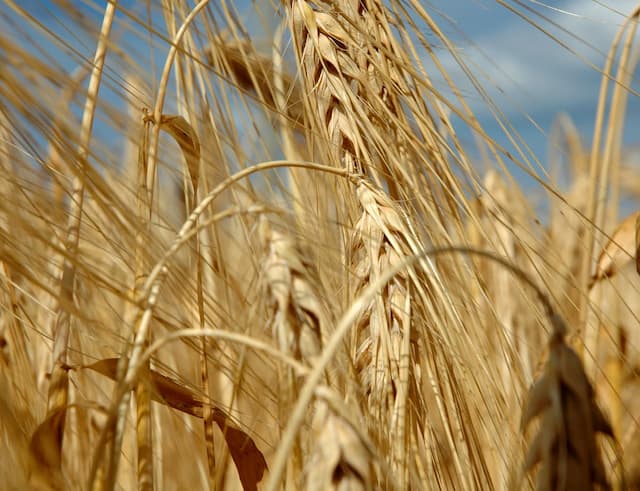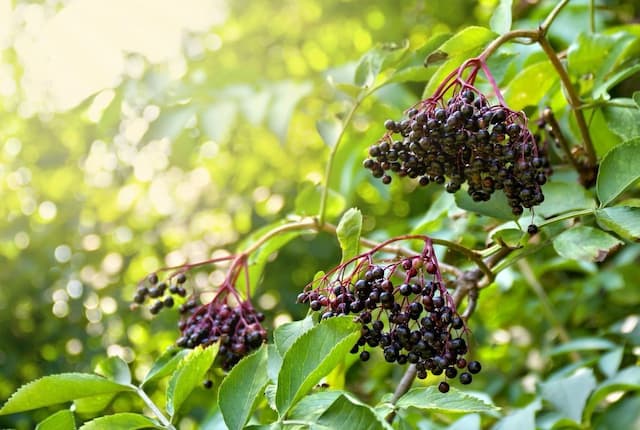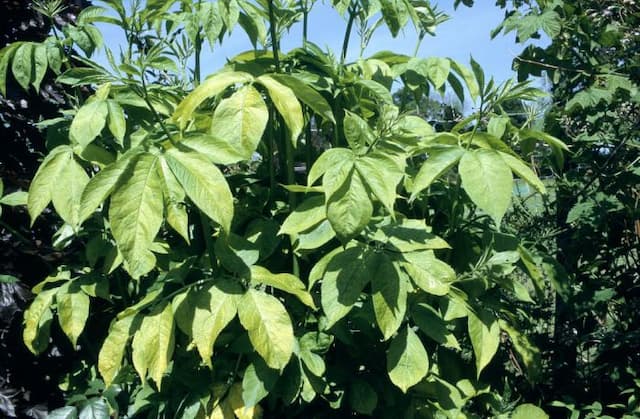Sweet viburnum Viburnum odoratissimum var. awabuki

ABOUT
The plant commonly known as Sweet Viburnum is characterized by its lustrous, deep green leaves that are leathery in texture. Each leaf is oval-shaped and comes to a gently pointed tip. Though the foliage is quite dense, each individual leaf stands out due to its substantial size and the well-defined veins that give it a distinct texture. Clusters of small, tubular flowers emerge in the spring. These blooms are highly fragrant and typically a creamy white color, creating an arresting contrast against the dark foliage. The blossoms are known for their aroma, which is sweet and pervasive, adding a sensory appeal to the plant’s aesthetic. Following the flowering period, Sweet Viburnum bears fruit that is generally spherical in shape. These berries evolve in hue from a light red, when immature, to a dark, almost black shade when fully ripe. The fruit adds a further point of interest to the plant's appearance and can attract birds and wildlife to your garden. Overall, the Sweet Viburnum is a popular choice for its combination of attractive, heavy foliage, pleasantly scented flowers, and visually appealing fruit, making it a versatile and ornamental addition to various landscapes.
About this plant
 Names
NamesFamily
Adoxaceae
Synonyms
Sweet Viburnum, Awabuki Viburnum, Mirror-Leaf Viburnum
Common names
Viburnum awabuki, Viburnum odoratissimum var. awabukii.
 Toxicity
ToxicityTo humans
The Sweet Viburnum is not considered highly toxic to humans. However, ingestion of large quantities of the berries may cause mild abdominal discomfort, nausea, or vomiting. In general, it is not considered dangerous, but it is advisable to prevent children from eating the berries as a precaution.
To pets
Sweet Viburnum is also not highly toxic to pets; however, like humans, ingestion of the berries could potentially cause mild gastrointestinal upset, including vomiting or diarrhea, if consumed in large amounts. It's recommended to keep an eye on pets and prevent them from eating the berries to avoid any potential discomfort.
 Characteristics
CharacteristicsLife cycle
Perennials
Foliage type
Evergreen
Color of leaves
Green
Flower color
White
Height
10-15 feet (3-4.5 meters)
Spread
6-10 feet (1.8-3 meters)
Plant type
Shrub
Hardiness zones
8
Native area
Asia
Benefits
 General Benefits
General Benefits- Landscape enhancement: Awabuki, commonly known as Sweet Viburnum, is often used in landscaping for its dense, glossy, and evergreen foliage which adds aesthetic appeal to gardens and parks.
- Privacy screen: The thick growth habit of Sweet Viburnum makes it an excellent choice for privacy screens or living fences, providing a natural barrier between properties.
- Noise reduction: The dense foliage can also help to reduce noise pollution, making it suitable for planting along roadsides or in urban areas.
- Shade provider: Sweet Viburnum can grow into a sizeable shrub or small tree, offering shade in gardens and outdoor spaces.
- Wildlife attraction: The plant produces small white flowers that are fragrant and attract various pollinators such as bees and butterflies, while its berries can provide food for birds.
- Low maintenance: Sweet Viburnum is known for being relatively low maintenance, requiring minimal pruning and being drought-tolerant once established.
- Windbreak: Its robust nature means it can be used as a windbreak, protecting other plants and outdoor areas from strong winds.
- Soil erosion control: The dense root system of Sweet Viburnum helps to stabilize soil, which can be beneficial on slopes or areas prone to erosion.
- Adaptable growth: This plant is adaptable to a variety of soil types and pH levels, making it a versatile choice for many landscapes.
- Seasonal interest: The glossy leaves, fragrant flowers in spring, and red to black berries in autumn offer year-round visual interest.
 Medical Properties
Medical PropertiesThis plant is not used for medical purposes.
 Air-purifying Qualities
Air-purifying QualitiesThis plant is not specifically known for air purifying qualities.
 Other Uses
Other Uses- Privacy Screening: Sweet Viburnum can be planted in rows to create a dense, evergreen privacy hedge that shields against unwanted views and noise pollution.
- Topiary or Formal Shapes: Its dense foliage allows it to be pruned into topiary shapes or formal hedging, adding a structured element to garden designs.
- Windbreak: The thick foliage of Sweet Viburnum can act as a windbreak, protecting gardens and homes from strong winds.
- Erosion Control: With its extensive root system, this plant can be used to stabilize slopes and prevent soil erosion in landscapes.
- Shade Provider: Large specimens can offer shade due to their size, making them suitable for planting in sunny areas where smaller plants might suffer from heat stress.
- Sound Barrier: This plant is utilized to muffle traffic noise when planted along roadsides or between properties.
- Cultural Significance: In some cultures, Sweet Viburnum is planted for its symbolic value of protection and preservation.
- Landscape Accent: Its attractive foliage and seasonal berries make Sweet Viburnum a noteworthy accent plant in mixed garden borders.
- Fauna Habitat: The dense canopy can provide shelter and nesting opportunities for birds and other small wildlife.
- Scented Garden Theme: With its fragrant flowers, Sweet Viburnum can be included in gardens designed specifically for their olfactory experience.
Interesting Facts
 Feng Shui
Feng ShuiThe Sweet Viburnum is not used in Feng Shui practice.
 Zodiac Sign Compitability
Zodiac Sign CompitabilityThe Sweet Viburnum is not used in astrology practice.
 Plant Symbolism
Plant Symbolism- Renewal: The Viburnum odoratissimum var. awabuki, commonly known as Sweet Viburnum, often symbolizes renewal because of its capacity to grow new leaves and rejuvenate itself, particularly after pruning or seasonal changes.
- Protection: Sweet Viburnum has a dense growing habit which can create a protective hedge, this lends to the symbolism of offering protection and shelter.
- Abundance: With prolific foliage and sometimes berries, Sweet Viburnum can represent abundance and the richness of life.
- Persistence: As a plant that can thrive in a variety of conditions, Sweet Viburnum stands for persistence and the ability to endure through hard times.
- Boundaries: With its use as a privacy screen in landscaping, Sweet Viburnum symbolizes the setting of boundaries and personal space.
 Water
WaterSweet viburnum (Viburnum odoratissimum var. awabuki) should be watered deeply, allowing the soil to become moist but not soggy. In the absence of rainfall, young plants typically need watering twice a week. Mature plants benefit from 1 inch of water per week, which translates to about 0.6 gallons per square foot every seven days. During hot or dry periods, the frequency should be increased. It's important to reduce watering during the winter months when the plant is not actively growing.
 Light
LightSweet viburnum prefers full sun to partial shade. The ideal spot for planting is an area that receives at least four hours of direct sunlight each day. While it can tolerate partial shade, too much shade may result in reduced flowering and a less dense growth habit.
 Temperature
TemperatureSweet viburnum thrives in a temperature range of 50°F to 80°F, which is ideal for vibrant growth. The plant can survive temperatures as low as 10°F but may sustain cold damage. It can tolerate heat well, but prolonged temperatures over 100°F can be detrimental.
 Pruning
PruningPrune sweet viburnum to maintain shape, remove damaged branches, and promote a healthy, dense growth. The best time for pruning is late winter or early spring before new growth begins. Pruning can be done annually, but the plant may also be pruned selectively throughout the year as needed.
 Cleaning
CleaningAs needed
 Soil
SoilSweet viburnum thrives in well-draining, moderately fertile soil with a slightly acidic to neutral pH (5.6 to 7.5). A good soil mix for this plant can be made by combining loamy garden soil, compost, and perlite or pine bark fines to ensure proper drainage and aeration.
 Repotting
RepottingSweet viburnum should typically be repotted every 2-3 years to prevent root-bound conditions and to refresh the soil. However, as it matures and grows larger, the frequency of repotting can be reduced.
 Humidity & Misting
Humidity & MistingSweet viburnum prefers moderate humidity levels but is quite adaptable and can tolerate lower humidity environments commonly found indoors.
 Suitable locations
Suitable locationsIndoor
Place in bright, indirect light and avoid dry air.
Outdoor
Plant in well-draining soil, partial to full sun.
Hardiness zone
8-10 USDA
 Life cycle
Life cycleViburnum odoratissimum var. awabuki, commonly known as Awabuki sweet viburnum, begins its life cycle with seed germination, often occurring in spring, where the radicle emerges from the seed to anchor the plant and start absorbing nutrients. This is followed by the seedling stage, where the first true leaves develop, enabling photosynthesis to fuel growth. As the plant enters the vegetative growth phase, it rapidly expands in height and girth, developing a strong stem, robust root system, and ample foliage through repeated cycles of leaf production. Flowering occurs as the plant matures, producing fragrant white flowers that attract pollinators and give way to small red to black berries. Once pollinated, these flowers develop into fruit which then, upon ripening, disperse their seeds to propagate the next generation of plants. The plant reaches maturity when it completes its structural growth, typically marked by achieving its full size and the capacity to produce viable seeds, which may then embark on their lifecycle, perpetuating the species.
 Propogation
PropogationPropogation time
Spring-Early Summer
Propogation: The most popular method of propagating the Sweet Viburnum (Viburnum odoratissimum var. awabuki) is through semi-hardwood cuttings. This process typically occurs in late summer. To propagate by cuttings, one must select a healthy, non-flowering shoot and cut a 4 to 6-inch (10 to 15 cm) section, making sure it contains several leaf nodes. The lower leaves are removed, and the cut end may be dipped in rooting hormone powder to enhance root development before placing the cutting in a well-draining potting mix. The environment should be kept humid and the soil consistently moist but not waterlogged, and the cuttings should be kept out of direct sunlight. Roots usually develop within a few weeks, after which time the new plants can eventually be transplanted into the garden.




![Elder [Black Tower]](/_next/image?url=https%3A%2F%2Fplants-admin.emdemapps.com%2Fimages%2Fplants%2F%2Fimages%2F604b5cad99578.png&w=640&q=75)




